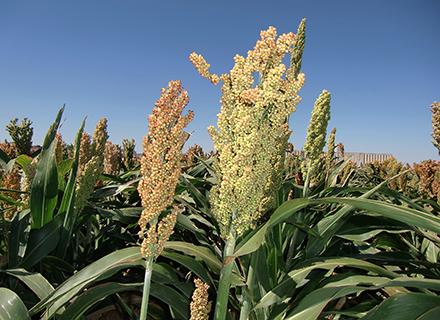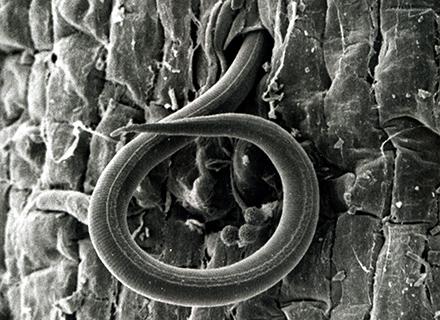New Sorghum Lines Ward Off the Southern Root-Knot Nematode

Sorghum flowering in a breeder’s field in Lubbock, Texas. (Photo by Peggy Greb, ARS)
Sorghum bicolor, commonly known as sorghum, is an important grain and forage crop. According to USDA’s National Agricultural Statistics Service, 6.3 million acres were harvested for sorghum in the United States last year, with a value of $1.5 billion.
Farmers plant sorghum as a crop in between seasons for other cash crops like cotton, corn, and soybean. Sorghum has a great advantage over other crops due to its drought tolerance and ability to grow in different climates like the southern United States.
Another advantage of planting sorghum is that even though it allows significant nematode reproduction it is not significantly damaged by Southern root-knot nematodes, the microscopic worms that usually feed on plant roots of popular cash crops.
“Unlike many crops, sorghum roots grow rapidly,” said ARS Research Plant Pathologist Richard Davis at the ARS Crop Genetics and Breeding Research Unit in Tifton, GA. “When nematodes infect sorghum, the galls (which are abnormal growths like tumors) are usually small and indistinct, so the plant itself is rarely damaged by nematodes.”
According to Davis, even though sorghum is spared by Southern root-knot nematodes’ damage, sorghum can be a good host for nematodes.

Whiplike larva of Southern root-knot nematode, magnified 500X, penetrate a tomato root. (Photos by William Wergin and Richard Sayre, ARS)
“Nematode levels build up in the soil, and the cash crops planted after sorghum grow poorly as the worms attack the new cash crops,” said Davis.
“These destructive worms can cause significant economic damage to crops like cotton, which results in nearly $100 million in losses each year in the United States.”
ARS researchers tackled this problem by first identifying sorghum genotypes, or lines, including a popular sweet sorghum line called ‘Honey Drip,’ that already have high levels of resistance to Southern root-knot nematodes.
“In our mapping studies, we have identified where genes that provide resistance to Southern root-knot nematodes are in the sorghum genome,” said Davis.
After identifying the section of DNA that contains the resistance gene, these scientists were able to move the resistance gene from ‘Honey Drip’ to susceptible sorghum lines to allow resistance to Southern root-knot nematodes.
“Using resistance genes in elite sorghum hybrids and lines could prevent the buildup of Southern root-knot nematodes in the soil as farmers continue to plant sorghum and protect their cash crops,” said Davis.
The research was done in collaboration with scientists at the ARS Plant Stress and Germplasm Development Research Unit in Lubbock, TX, and recently published in Nematropica. – by Jessica Ryan, ARS Office of Communications
###

